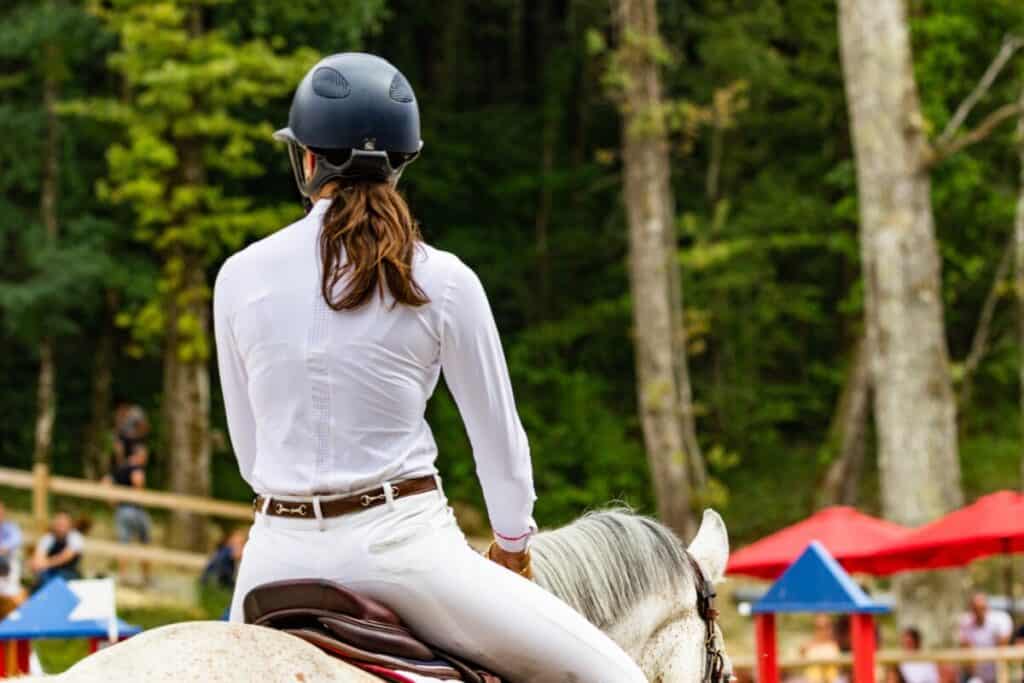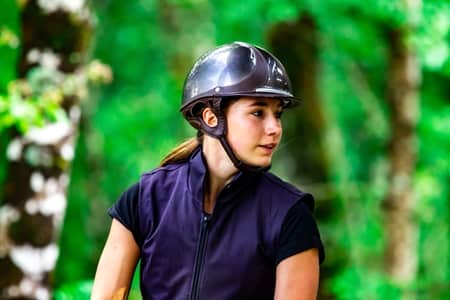
When you watch a sport, it’s usually clear to see what parts of the body the athlete is using; a footballer uses their legs and feet, a tennis player uses their arms to hit the ball and their feet to run around. We all know there is more to it than that, but you could take a good guess at what muscles are getting toned, just by looking at the person’s movements. The same can’t be said for horseback riders. You might even be forgiven for thinking that it isn’t a great sport for getting fit or toning muscles at all. That is until you try it!
Even after 30 minutes of moderate riding, you’ll be feeling things in places you didn’t know existed and realizing that it’s actually quite the workout. You need to be fit to ride a horse effectively, and if you’re not already, then regular riding will certainly improve your general fitness, but what muscles does horseback riding tone?
Your first horseback riding experience is likely to leave you feeling sore in your legs, hips, and butt. This is because of the unusual position adopted while riding; sitting astride the horse causes a unique kind of hip rotation. Also, because you naturally tense these areas when trying to stay on the horse, they get a workout while you’re up there.
Unfortunately, that tension also causes you to bounce around all over the place; not how you see the professionals doing it, and not very pleasant for you or your horse. The more experienced rider engages their core to create stability, working the abs, the back, the glutes, and anchors themselves deep in the saddle through their feet. Everything else is then able to relax and move fluidly with the horse, also working the hip flexors. Once they have mastered this control, the rider will be able to use a series of subtle movements for communication and balance – toning up a whole host of other muscles in the process.
LEGS
Mounting
Before anything else, you need to get on the horse, and this will require you to have a lot of power in your quads; both to push off the ground and to pull yourself up and into the saddle. You don’t want to pull on the saddle to get you there as this is very bad for your horse’s back, so only ever use it for balance as you’re firing yourself into position. If you can’t mount from the ground at first, then use a mounting block and gradually build up to mounting from the ground as you gain strength in your legs and flexibility in your hips. If you don’t have a mounting block, have a read through our tips for mounting a horse without a mounting block.
Riding Position
Once you’re in the saddle, your stirrups should be at a length which allows your legs to wrap around the side of the horse and put your weight down into your heels, creating alignment from your shoulder to your hip to your ankle. Once seated correctly, you should feel a slight stretch in your calf muscles.
Rising Trot
When you perform a rising trot, which is the action of rising out of the saddle and sitting back down again, in time with the horse’s gait, your thigh and butt muscles (quads and glutes) get a thorough workout. You need to really drive this movement and stay ahead of your horse so you don’t bounce on his back or right out of the saddle! It’s kind of like doing squats, but on a moving target! If you feel like you are struggling with the rising trot, you may benefit from doing some targeted workouts for the legs and core as well as practice your balance. Come train with us over on the Horse Learner YouTube channel where we post workouts created for equestrians.
Staying Aboard
When your horse moves unexpectedly, you’ll learn to grip with your knees and quads and use your core to keep yourself balanced and avoid pulling on his mouth or having to grab the saddle.
Keeping Pace
The rider’s legs are used in horseback riding to signal to the horse that he should pick up speed. Putting ‘leg on’ means applying pressure with the lower leg to ask him to move forwards. The action of putting your ‘leg on’ without moving the rest of your body requires strength and agility, which will naturally build tone.
TORSO
It often looks like riders aren’t moving their torsos at all but that’s just because their movements are aligned with those of the horse.
Changing Direction
It’s mainly the oblique muscles doing the work here. These are the muscles that allow your upper body to twist and turn. The rider must always be a fraction of a second ahead of the horse to avoid being unseated. Engaging the obliques to move in the direction you want the horse to go, will keep you square on top of him.
Protecting the Back
Properly engaging the core abdominal muscles (rectus abdominus, internal and external oblique, transversus abdominus) is vital when horse riding, to keep you balanced and protect your spine. If using them properly, these muscles will get a real workout during your ride, and the bonus is that you won’t get backache! If you find you do get lower back pain after a ride – or if you notice yourself leaning to one side – then it probably means that your abdominal strength needs some work out of the saddle. Invest that time as it not only keeps you safe but improves your riding technique and keeps your horse’s back nice and relaxed as well. We challenge to complete the 7-Day Core Activation Series on our YouTube Channel to build up some foundational strength!
BACK, PELVIS AND HIPS
The lower back, pelvis, and hips must all move fluidly, in time with the horse. This involves the hips swaying back and forth or even rotating to keep the rider perfectly balanced.
Whilst this movement uses muscles and burns calories, it’s not necessarily going to tone any particular area that’s visible as the muscles used are deep inside your body. It will make you more flexible though, and you should complement this with stretches outside of the saddle to ensure you stay as agile as possible. Being able to quickly adjust your seat position could save your bacon if your horse decides to move suddenly.
BUTT
Yes, horse riding is going to help to tone your butt. That’s because your butt muscles – or glutes, must be strong so that you can perform exercises like rising trot, and because your glutes will flex and contract as your hips move, regardless whether you’re walking, trotting or cantering.
Jumping
When jumping, we lift ourselves a little out of the saddle and lean forwards so that we are ahead of the horse’s movement and don’t crash down on to his back when he lands. Maintaining this position during big, bold jumping movements from your horse will create strength and tone in your glutes and thighs as they tense and flex to keep you balanced.
Upper Body and Arms
You might hear a more experienced rider talk about keeping a horse ‘collected’, and not letting his energy ‘fall out of the front end’. This is all about creating the forward movement from the leg that we mentioned before, and maintaining good contact with his mouth so that he doesn’t run forwards but instead has a rounded, even pace. Achieving this takes strength in the arms, chest, and shoulders, and will tone these areas.
If you have a particularly strong horse, who pulls or shakes his head whilst being ridden, you should try everything to discourage this behavior and use your core and a quiet seat to help control him. This is easier said than done, however, and in reality, you may well end up with triceps and lats of steel!
Stable Duties
As well as the horseback riding itself, all the work that goes along with keeping horses will help to get you fit and toned. Carrying water buckets, lifting feed bags, twisting and bending while grooming, digging, and pushing to muck out – these activities provide a workout that would give most gym session a run for its money.
The unique thing about horseback riding as a sport is that it involves another living, breathing, unpredictable being, and a powerful one, at that! The movements of the horse are very obvious; next to their grand paces and rippling muscles, it’s no wonder that the more subtle work of the rider can often go unnoticed. Yet, if the horse is in constant motion then the rider must also be in constant motion. Even at a standstill, the rider’s core must remain engaged so to stay anchored in the saddle if the horse moves unexpectedly.
At a walking pace, the engaged core is joined by hip movements and therefore thighs and glutes flexing and tensing. Step it up a gear to trot, canter, or jumping; compelling and controlling the movements of the horse at a pace like this, or over obstacles, requires a sophisticated combination of coordinated movements (as well as patience, practice, and agility). The type of riding you are doing and the temperament of your horse will have an impact on the extent to which you use certain muscle groups, but for the most part, your entire body will get a workout from horseback riding and you can be sure to get more toned as a result!


